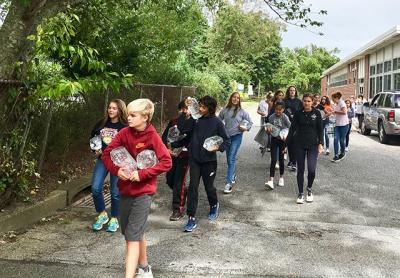A Subtle Lesson in Carrying Water

On Monday, a group of grumpy seventh graders in Cara Nelson’s social studies class, Rita Green’s English language arts class, and Meg Ryan-Metz’s special education class walked from the East Hampton Middle School to the high school, and back, each carrying two one-gallon bottles of water in their arms, or on their shoulders, and huffing and puffing during the approximately 30-minute round trip.
“This is so stupid,” one student said. Another curled her upper lip and rolled her eyes. They returned to school evidently exhausted. Asked to describe on a chalkboard in Ms. Nelson’s classroom how they felt during the exercise, scrawled descriptions read: “Abused,” “deceased,” “never want to do it again,” and “felt like army training.”
Seventh graders had just received a lesson in experiential learning. The next day they began reading “A Long Walk to Water” by Linda Sue Park. The short novel is based on the true story of a 12-year-old Sudanese girl who walks two hours each way, twice daily, to retrieve water from the nearest pond. After reading only the title, a lightbulb went off for some, Ms. Green said, and suddenly it clicked.
By taking the learners outside their comfort zone — the classroom — for a memorable lesson, the students had been offered a chance to reflect on what they were being taught from firsthand experience.
The three teachers are pushing the boundaries of traditional techniques in other ways as well. They have championed a linked-teaching model connecting the seventh grade social studies unit on migration to E.L.A. topics on identity and global cultures.
“We tried to find organic connections between the two subjects,” Ms. Ryan-Metz, who teaches both social studies and E.L.A. to special education pupils, said. “And the connections are endless.” She said that Charles Soriano, the middle school principal, is entirely on board with the integrated method, which is now in its fourth year.
The flexibility to deliver core subjects in ways that engage students outside of the classroom is seen by many educators as a key to their becoming lifelong learners. By introducing more projects into the curriculum, in which students gain knowledge and skills through actively investigating and partici pating in a certain challenge, teachers become guides and students develop critical thinking. “This really puts learning into the kids’ hands. This is not a teacher-centered way of teaching,” Ms. Nelson said.
The East Hampton teachers have introduced yet another outside-the-classroom learning opportunity. Beginning four years ago in conjunction with the Hamptons International Film Festival, East Hampton’s seventh graders have created short videos. Working in small groups, they chose a topic related to E.L.A. or social studies, such as migration, diversity, refugees, immigration, identity, global issues, and animal rights, and are creating a two to five-minute film in any format — live action, stop motion, animation, or slide shows. Each year, films are submitted to a junior offshoot of the festival, and the strongest are selected for a screening and panel discussion at the John M. Marshall Elementary School in May.
Next Thursday, the first day of this year’s festival, the entire middle school, along with students from neighboring schools, will attend a screening of short films by young filmmakers from Italy, Bangladesh, Belgium, and Slovenia, among other countries, which were chosen in conjunction with the Plural+ Film Festival, a joint venture of the United Nations Alliance of Civilizations and the International Organization for Migration. The narrative themes featured this year are diversity, migration, and social inclusion.
As a surprise, a few films made by last year’s seventh graders who worked with Ms. Nelson, Ms. Green, and Ms. Ryan-Metz will be shown at the event, providing ample inspiration for this year’s new filmmakers.
